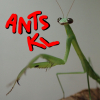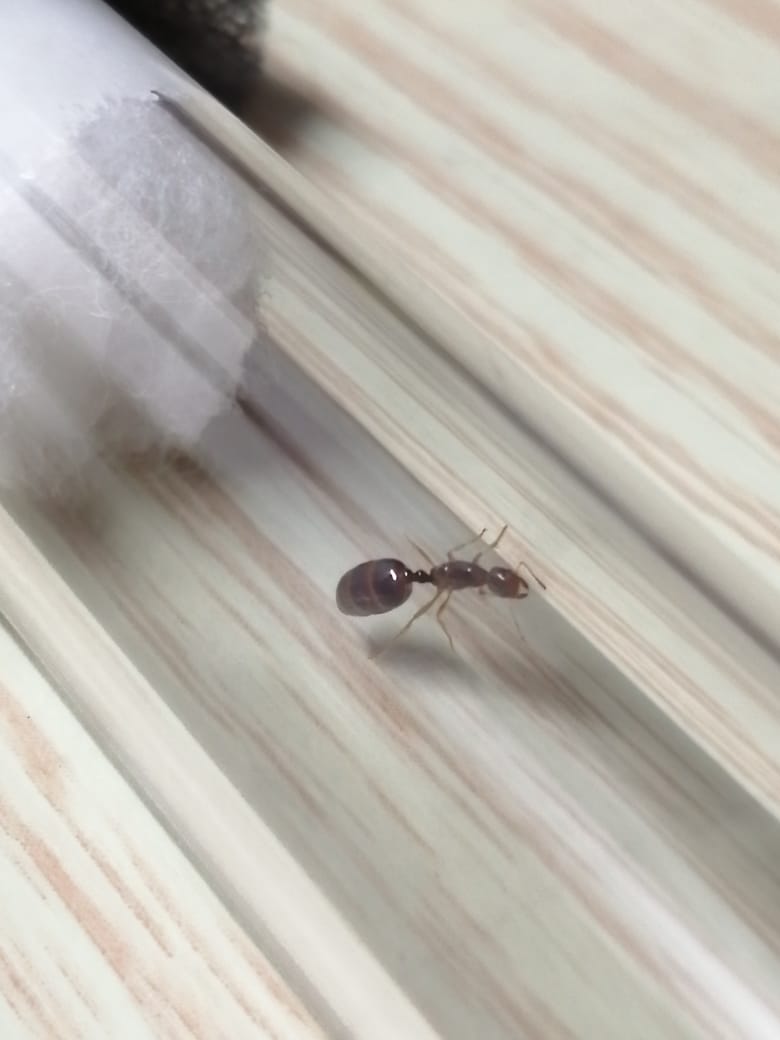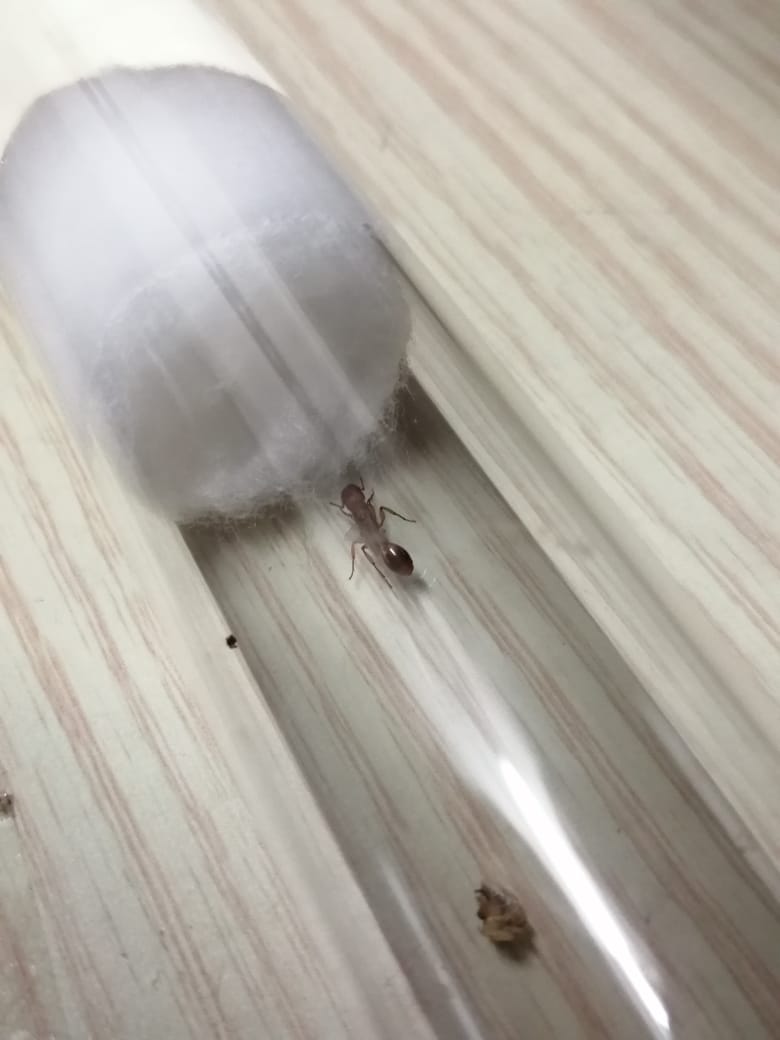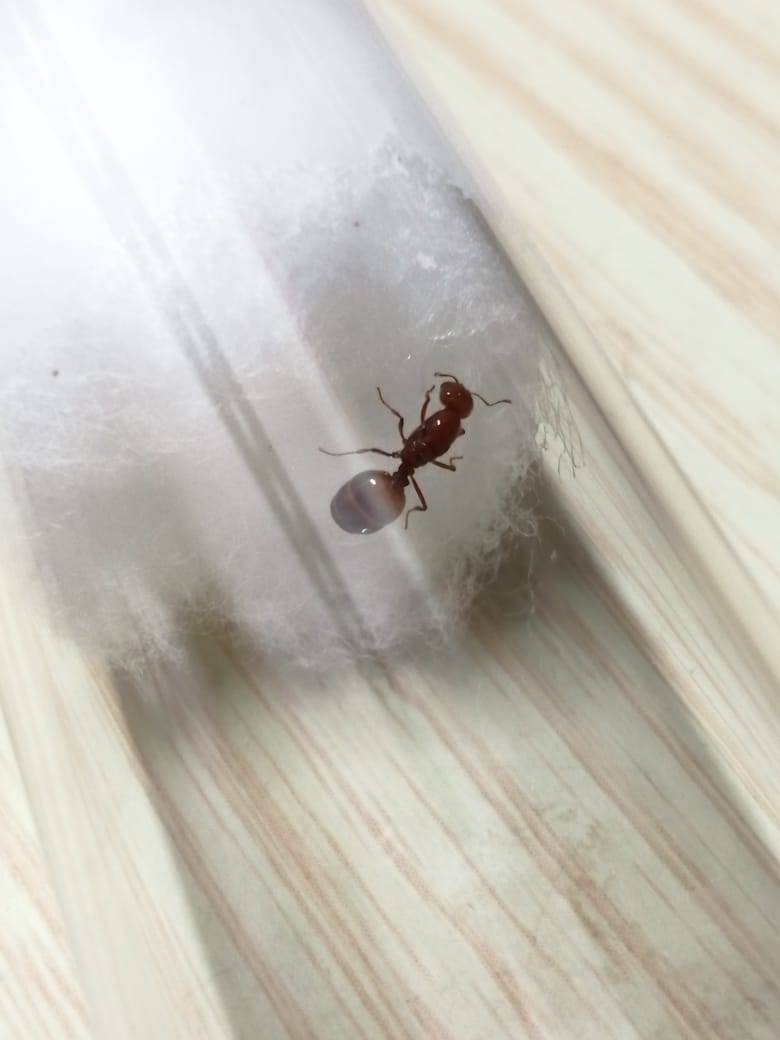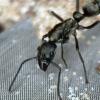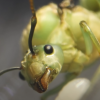- Formiculture.com
- Forums
- Gallery
- Members
- Member Map
- Chat
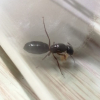
356 replies to this topic
#141
 Offline
-
Posted September 30 2021 - 11:06 PM
Offline
-
Posted September 30 2021 - 11:06 PM
Give me ur address and I will steal ur iridomyrmex queen
Jkjk lmao
But srsly how tf r u so lucky. I have been searching for 2 months straight with absolutely no luck at all. The only thing I found was a small BCA satellite nest with no queen...
Camponotus and iridomyrmex anceps appearing at my house when. Also send a couple of pics for the Crematogaster queen.
Sent from my CPH2201 using Tapatalk
Also I would like to point out that my Crematogaster queen was also injured but survived. She just died bcs of the heat lol.
Sent from my CPH2201 using Tapatalk
Jkjk lmao
But srsly how tf r u so lucky. I have been searching for 2 months straight with absolutely no luck at all. The only thing I found was a small BCA satellite nest with no queen...
Camponotus and iridomyrmex anceps appearing at my house when. Also send a couple of pics for the Crematogaster queen.
Sent from my CPH2201 using Tapatalk
Also I would like to point out that my Crematogaster queen was also injured but survived. She just died bcs of the heat lol.
Sent from my CPH2201 using Tapatalk
- Antkeeper01 likes this
Young ant keeper with a decent amount of knowledge on local ant species.
YouTube: https://m.youtube.co...uKsahGliSH7EqOQ (It's pretty dead. Might upload again soon, don't expect my voice to sound the same though.)
Currently kept ant species, favorites have a star in front of their names (NOT in alphabetical order, also may be outdated sometimes): ★ Camponotus irritans inferior, ★ Ooceraea biroi, Pheidole parva, ★ Nylanderia sp., ★ Paraparatrechina tapinomoides, Platythyrea sp., Anochetus sp., Colobopsis sp. (cylindrica group), ★ Crematogaster ferrarii, Polyrhachis (Myrma) cf. pruinosa, Polyrhachis (Cyrtomyrma) laevissima, Tapinoma sp. (formerly Zatapinoma)
Death count: Probably over a hundred individual queens and colonies by now. I cannot recall whatsoever.
YouTube: https://m.youtube.co...uKsahGliSH7EqOQ (It's pretty dead. Might upload again soon, don't expect my voice to sound the same though.)
Currently kept ant species, favorites have a star in front of their names (NOT in alphabetical order, also may be outdated sometimes): ★ Camponotus irritans inferior, ★ Ooceraea biroi, Pheidole parva, ★ Nylanderia sp., ★ Paraparatrechina tapinomoides, Platythyrea sp., Anochetus sp., Colobopsis sp. (cylindrica group), ★ Crematogaster ferrarii, Polyrhachis (Myrma) cf. pruinosa, Polyrhachis (Cyrtomyrma) laevissima, Tapinoma sp. (formerly Zatapinoma)
Death count: Probably over a hundred individual queens and colonies by now. I cannot recall whatsoever.
#142
 Offline
-
Posted September 30 2021 - 11:24 PM
Offline
-
Posted September 30 2021 - 11:24 PM
It depends on where you live, that night I stayed in my grandmother's home which has a lot of plantations nearby and there's a nuptial flight happening there and I found that Iridomyrmex queen. I found the Crematogaster and trap jaw queen in a plantation (the trap jaw already had eggs when I found her and I took the eggs with her.) and the Euponera alate just when I was about to go home.
Anyway, if you want to find Iridomyrmex, you should start looking now, they tend to fly in at the end and beginning of the year from late September to mid-March.
The Crematogaster queen is currently still alive and I'll start posting pics soon. She's a large fully black species.
Euponera still has her wings on. Oh and apparently she can climb glass. ![]()
Edited by SYUTEO, September 30 2021 - 11:32 PM.
- Antkeeper01 likes this
Began antkeeping in 2018 
All ant journal: https://www.formicul...os-ant-journal/
Currently keeping colonies: Camponotus sp, Oecophylla smaragdina
All ant journal: https://www.formicul...os-ant-journal/
Currently keeping colonies: Camponotus sp, Oecophylla smaragdina
#143
 Offline
-
Posted October 1 2021 - 2:01 AM
Offline
-
Posted October 1 2021 - 2:01 AM
All Crematogaster climb glass for me ;-;It depends on where you live, that night I stayed in my grandmother's home which has a lot of plantations nearby and there's a nuptial flight happening there and I found that Iridomyrmex queen. I found the Crematogaster and trap jaw queen in a plantation (the trap jaw already had eggs when I found her and I took the eggs with her.) and the Euponera alate just when I was about to go home.
Anyway, if you want to find Iridomyrmex, you should start looking now, they tend to fly in at the end and beginning of the year from late September to mid-March.
The Crematogaster queen is currently still alive and I'll start posting pics soon. She's a large fully black species.
Euponera still has her wings on. Oh and apparently she can climb glass.
Also I live near a huge park
Sent from my CPH2201 using Tapatalk
Young ant keeper with a decent amount of knowledge on local ant species.
YouTube: https://m.youtube.co...uKsahGliSH7EqOQ (It's pretty dead. Might upload again soon, don't expect my voice to sound the same though.)
Currently kept ant species, favorites have a star in front of their names (NOT in alphabetical order, also may be outdated sometimes): ★ Camponotus irritans inferior, ★ Ooceraea biroi, Pheidole parva, ★ Nylanderia sp., ★ Paraparatrechina tapinomoides, Platythyrea sp., Anochetus sp., Colobopsis sp. (cylindrica group), ★ Crematogaster ferrarii, Polyrhachis (Myrma) cf. pruinosa, Polyrhachis (Cyrtomyrma) laevissima, Tapinoma sp. (formerly Zatapinoma)
Death count: Probably over a hundred individual queens and colonies by now. I cannot recall whatsoever.
YouTube: https://m.youtube.co...uKsahGliSH7EqOQ (It's pretty dead. Might upload again soon, don't expect my voice to sound the same though.)
Currently kept ant species, favorites have a star in front of their names (NOT in alphabetical order, also may be outdated sometimes): ★ Camponotus irritans inferior, ★ Ooceraea biroi, Pheidole parva, ★ Nylanderia sp., ★ Paraparatrechina tapinomoides, Platythyrea sp., Anochetus sp., Colobopsis sp. (cylindrica group), ★ Crematogaster ferrarii, Polyrhachis (Myrma) cf. pruinosa, Polyrhachis (Cyrtomyrma) laevissima, Tapinoma sp. (formerly Zatapinoma)
Death count: Probably over a hundred individual queens and colonies by now. I cannot recall whatsoever.
#144
 Offline
-
Posted October 1 2021 - 2:39 AM
Offline
-
Posted October 1 2021 - 2:39 AM
All Crematogaster climb glass for me ;-;It depends on where you live, that night I stayed in my grandmother's home which has a lot of plantations nearby and there's a nuptial flight happening there and I found that Iridomyrmex queen. I found the Crematogaster and trap jaw queen in a plantation (the trap jaw already had eggs when I found her and I took the eggs with her.) and the Euponera alate just when I was about to go home.
Anyway, if you want to find Iridomyrmex, you should start looking now, they tend to fly in at the end and beginning of the year from late September to mid-March.
The Crematogaster queen is currently still alive and I'll start posting pics soon. She's a large fully black species.
Euponera still has her wings on. Oh and apparently she can climb glass.
Also I live near a huge park
Sent from my CPH2201 using Tapatalk
No no no, I meant the Euponera queen, it's surprising to me as it's the first time seeing a Ponerine ant being able to climb smooth glass.
- Antkeeper01 and ANTS_KL like this
Began antkeeping in 2018 
All ant journal: https://www.formicul...os-ant-journal/
Currently keeping colonies: Camponotus sp, Oecophylla smaragdina
All ant journal: https://www.formicul...os-ant-journal/
Currently keeping colonies: Camponotus sp, Oecophylla smaragdina
#145
 Offline
-
Posted October 1 2021 - 3:31 AM
Offline
-
Posted October 1 2021 - 3:31 AM
Oh it's not unusualNo no no, I meant the Euponera queen, it's surprising to me as it's the first time seeing a Ponerine ant being able to climb smooth glass.All Crematogaster climb glass for me ;-;It depends on where you live, that night I stayed in my grandmother's home which has a lot of plantations nearby and there's a nuptial flight happening there and I found that Iridomyrmex queen. I found the Crematogaster and trap jaw queen in a plantation (the trap jaw already had eggs when I found her and I took the eggs with her.) and the Euponera alate just when I was about to go home.
Anyway, if you want to find Iridomyrmex, you should start looking now, they tend to fly in at the end and beginning of the year from late September to mid-March.
The Crematogaster queen is currently still alive and I'll start posting pics soon. She's a large fully black species.
Euponera still has her wings on. Oh and apparently she can climb glass.
Also I live near a huge park
Sent from my CPH2201 using Tapatalk
Sent from my CPH2201 using Tapatalk
- Antkeeper01 likes this
Young ant keeper with a decent amount of knowledge on local ant species.
YouTube: https://m.youtube.co...uKsahGliSH7EqOQ (It's pretty dead. Might upload again soon, don't expect my voice to sound the same though.)
Currently kept ant species, favorites have a star in front of their names (NOT in alphabetical order, also may be outdated sometimes): ★ Camponotus irritans inferior, ★ Ooceraea biroi, Pheidole parva, ★ Nylanderia sp., ★ Paraparatrechina tapinomoides, Platythyrea sp., Anochetus sp., Colobopsis sp. (cylindrica group), ★ Crematogaster ferrarii, Polyrhachis (Myrma) cf. pruinosa, Polyrhachis (Cyrtomyrma) laevissima, Tapinoma sp. (formerly Zatapinoma)
Death count: Probably over a hundred individual queens and colonies by now. I cannot recall whatsoever.
YouTube: https://m.youtube.co...uKsahGliSH7EqOQ (It's pretty dead. Might upload again soon, don't expect my voice to sound the same though.)
Currently kept ant species, favorites have a star in front of their names (NOT in alphabetical order, also may be outdated sometimes): ★ Camponotus irritans inferior, ★ Ooceraea biroi, Pheidole parva, ★ Nylanderia sp., ★ Paraparatrechina tapinomoides, Platythyrea sp., Anochetus sp., Colobopsis sp. (cylindrica group), ★ Crematogaster ferrarii, Polyrhachis (Myrma) cf. pruinosa, Polyrhachis (Cyrtomyrma) laevissima, Tapinoma sp. (formerly Zatapinoma)
Death count: Probably over a hundred individual queens and colonies by now. I cannot recall whatsoever.
#146
 Offline
-
Posted October 1 2021 - 4:29 AM
Offline
-
Posted October 1 2021 - 4:29 AM
Oh it's not unusual
No no no, I meant the Euponera queen, it's surprising to me as it's the first time seeing a Ponerine ant being able to climb smooth glass.
All Crematogaster climb glass for me ;-;It depends on where you live, that night I stayed in my grandmother's home which has a lot of plantations nearby and there's a nuptial flight happening there and I found that Iridomyrmex queen. I found the Crematogaster and trap jaw queen in a plantation (the trap jaw already had eggs when I found her and I took the eggs with her.) and the Euponera alate just when I was about to go home.
Anyway, if you want to find Iridomyrmex, you should start looking now, they tend to fly in at the end and beginning of the year from late September to mid-March.
The Crematogaster queen is currently still alive and I'll start posting pics soon. She's a large fully black species.
Euponera still has her wings on. Oh and apparently she can climb glass.
Also I live near a huge park
Sent from my CPH2201 using Tapatalk
Sent from my CPH2201 using Tapatalk
I thought all Ponerines can't climb glass.
- Antkeeper01 and ANTS_KL like this
Began antkeeping in 2018 
All ant journal: https://www.formicul...os-ant-journal/
Currently keeping colonies: Camponotus sp, Oecophylla smaragdina
All ant journal: https://www.formicul...os-ant-journal/
Currently keeping colonies: Camponotus sp, Oecophylla smaragdina
#147
 Offline
-
Posted October 2 2021 - 1:40 AM
Offline
-
Posted October 2 2021 - 1:40 AM
Here are the pics:
Paratrechina longicornis (BCA), for some reason, they decided to place cotton on the brood.
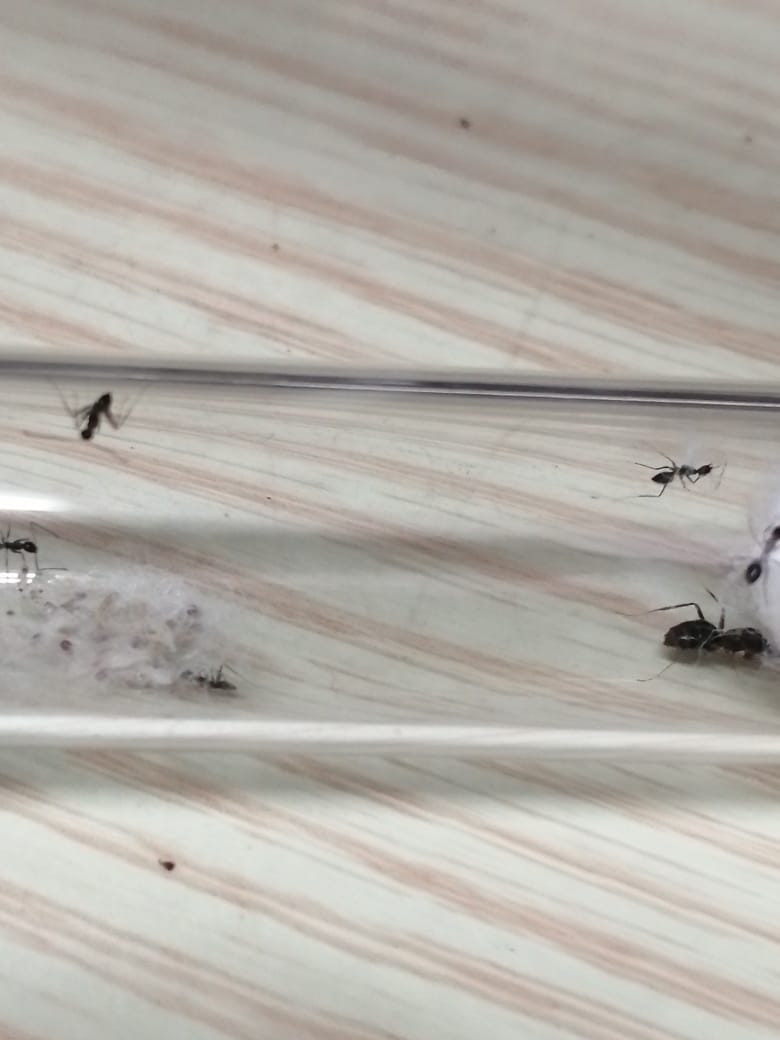
Odontomachus simillimus
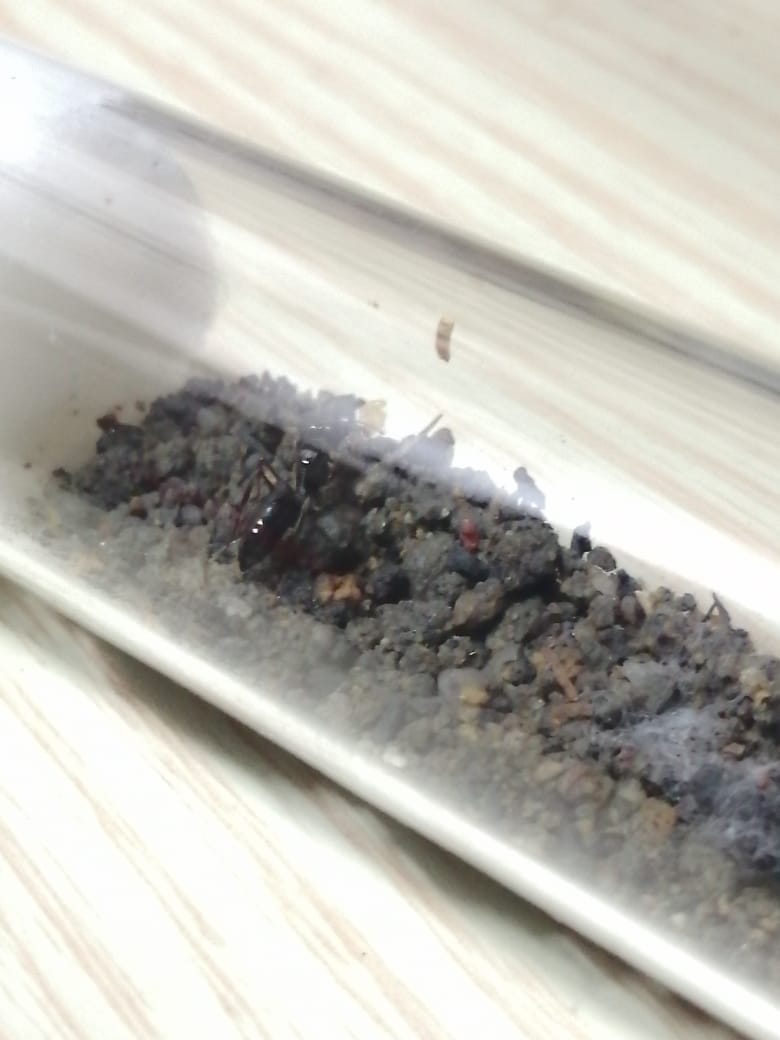
Eupoenra cf sharpi, she still has her wings on unfortunately.
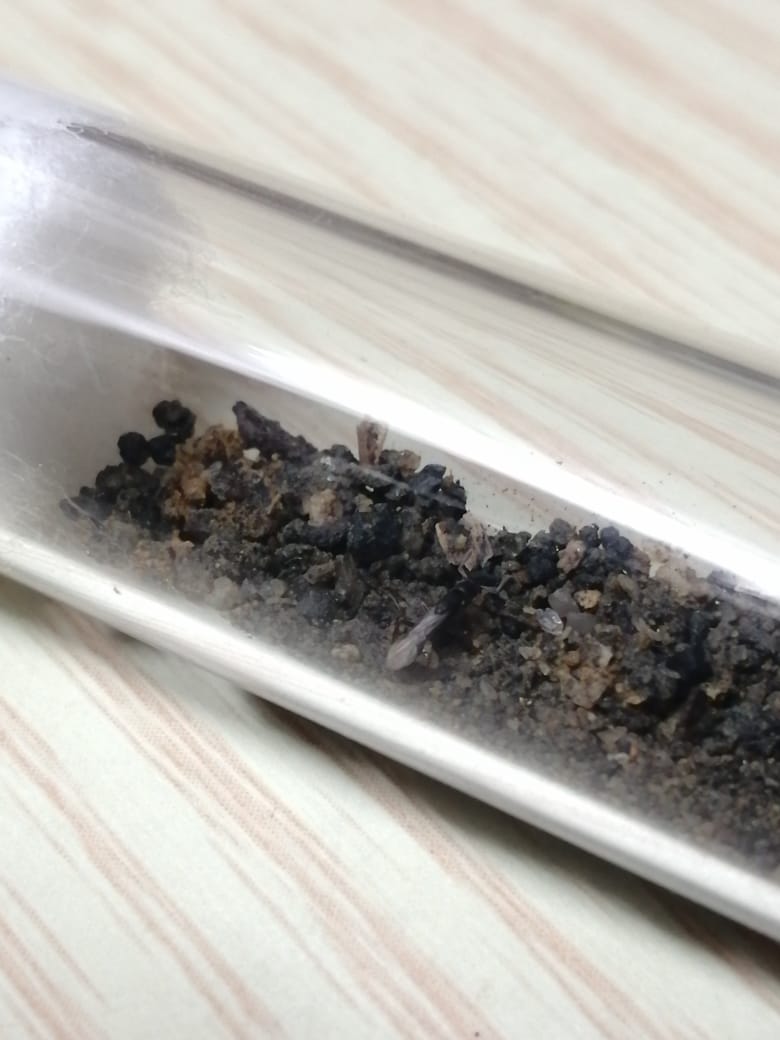
Iridomyrmex anceps, she has already laid eggs! ![]()
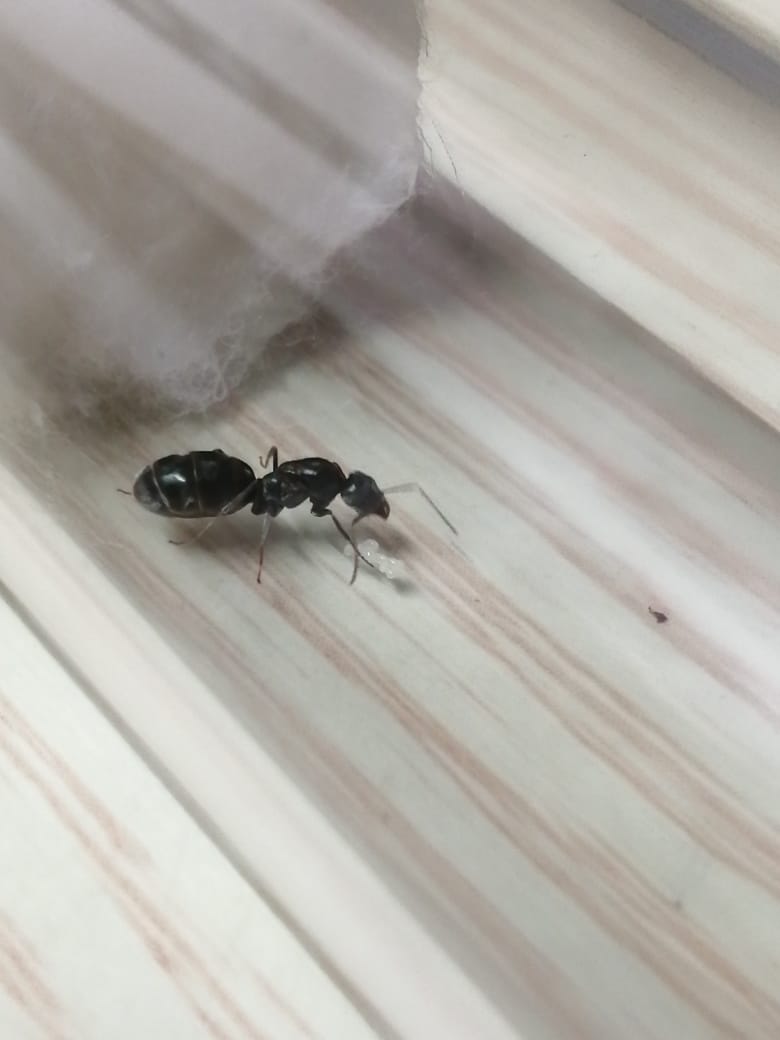
Monomorium monomorium, this colony has a HUGE brood pile.
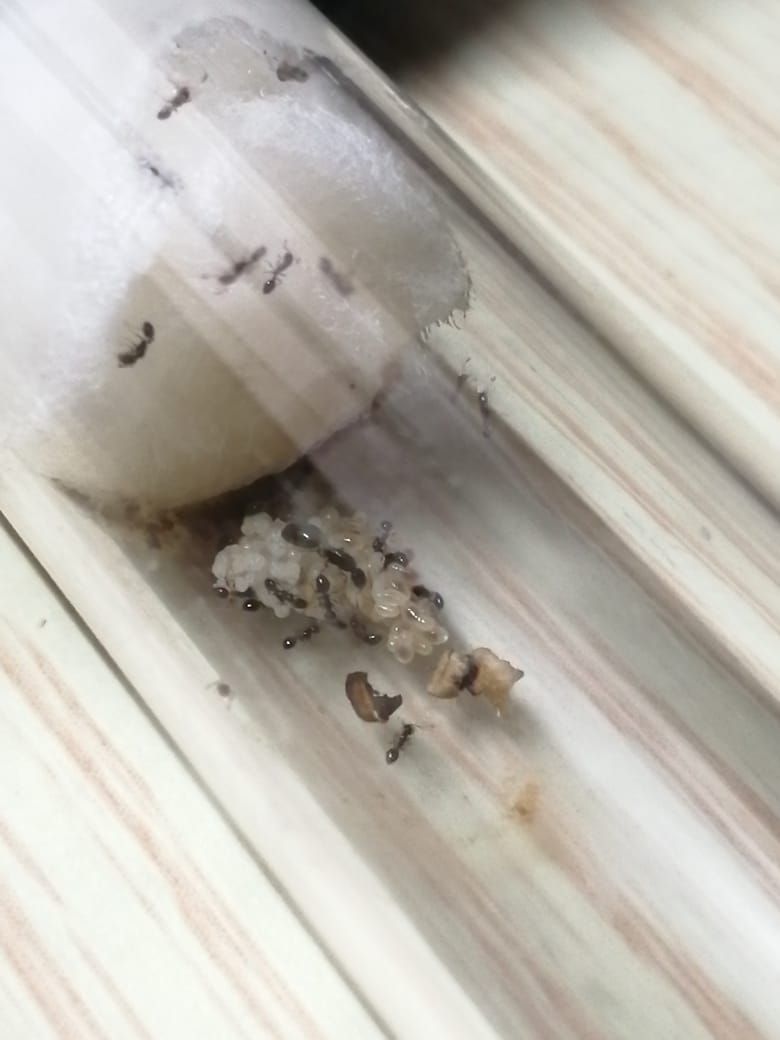
- smares and Antkeeper01 like this
Began antkeeping in 2018 
All ant journal: https://www.formicul...os-ant-journal/
Currently keeping colonies: Camponotus sp, Oecophylla smaragdina
All ant journal: https://www.formicul...os-ant-journal/
Currently keeping colonies: Camponotus sp, Oecophylla smaragdina
#148
 Offline
-
Posted October 2 2021 - 5:06 AM
Offline
-
Posted October 2 2021 - 5:06 AM
I want iridomyrmexHere are the pics:
Paratrechina longicornis (BCA), for some reason, they decided to place cotton on the brood.
Odontomachus simillimus
Eupoenra cf sharpi, she still has her wings on unfortunately.
Iridomyrmex anceps, she has already laid eggs!
Monomorium monomorium, this colony has a HUGE brood pile.
Sent from my CPH2201 using Tapatalk
- Antkeeper01 likes this
Young ant keeper with a decent amount of knowledge on local ant species.
YouTube: https://m.youtube.co...uKsahGliSH7EqOQ (It's pretty dead. Might upload again soon, don't expect my voice to sound the same though.)
Currently kept ant species, favorites have a star in front of their names (NOT in alphabetical order, also may be outdated sometimes): ★ Camponotus irritans inferior, ★ Ooceraea biroi, Pheidole parva, ★ Nylanderia sp., ★ Paraparatrechina tapinomoides, Platythyrea sp., Anochetus sp., Colobopsis sp. (cylindrica group), ★ Crematogaster ferrarii, Polyrhachis (Myrma) cf. pruinosa, Polyrhachis (Cyrtomyrma) laevissima, Tapinoma sp. (formerly Zatapinoma)
Death count: Probably over a hundred individual queens and colonies by now. I cannot recall whatsoever.
YouTube: https://m.youtube.co...uKsahGliSH7EqOQ (It's pretty dead. Might upload again soon, don't expect my voice to sound the same though.)
Currently kept ant species, favorites have a star in front of their names (NOT in alphabetical order, also may be outdated sometimes): ★ Camponotus irritans inferior, ★ Ooceraea biroi, Pheidole parva, ★ Nylanderia sp., ★ Paraparatrechina tapinomoides, Platythyrea sp., Anochetus sp., Colobopsis sp. (cylindrica group), ★ Crematogaster ferrarii, Polyrhachis (Myrma) cf. pruinosa, Polyrhachis (Cyrtomyrma) laevissima, Tapinoma sp. (formerly Zatapinoma)
Death count: Probably over a hundred individual queens and colonies by now. I cannot recall whatsoever.
#149
 Offline
-
Posted October 2 2021 - 6:32 AM
Offline
-
Posted October 2 2021 - 6:32 AM
I want iridomyrmexHere are the pics:
Paratrechina longicornis (BCA), for some reason, they decided to place cotton on the brood.
Odontomachus simillimus
Eupoenra cf sharpi, she still has her wings on unfortunately.
Iridomyrmex anceps, she has already laid eggs!
Monomorium monomorium, this colony has a HUGE brood pile.nature is cruel to me
Sent from my CPH2201 using Tapatalk
Keep believing yourself and look for some at night and maybe try going to different places and eventually you'll find some.
- Antkeeper01 and ANTS_KL like this
Began antkeeping in 2018 
All ant journal: https://www.formicul...os-ant-journal/
Currently keeping colonies: Camponotus sp, Oecophylla smaragdina
All ant journal: https://www.formicul...os-ant-journal/
Currently keeping colonies: Camponotus sp, Oecophylla smaragdina
#150
 Offline
-
Posted October 3 2021 - 11:17 PM
Offline
-
Posted October 3 2021 - 11:17 PM
You might not believe it but I caught three more queens last night! But before I tell you more about those queens, there are some updates on the other colonies.
BCA has mites, but luckily these mites ONLY attack P. longicornis brood so hopefully they won't spread to other colonies, I wonder how am I going get these mites off. ![]()
Tetramorium has 5 workers.
Odontomachus laid more eggs.
Now for the new queens I caught. The first one is an unknown species.
The second one is a Paratopula sp queen alate.
And the last one is a Solenopsis geminata queen. Funny story about this queen, I didn't actually find this queen, an Odontoponera worker found it and I managed to catch it before she can (I fell bad for her though).
- Antkeeper01 likes this
Began antkeeping in 2018 
All ant journal: https://www.formicul...os-ant-journal/
Currently keeping colonies: Camponotus sp, Oecophylla smaragdina
All ant journal: https://www.formicul...os-ant-journal/
Currently keeping colonies: Camponotus sp, Oecophylla smaragdina
#151
 Offline
-
Posted October 3 2021 - 11:22 PM
Offline
-
Posted October 3 2021 - 11:22 PM
The unknown is Trichomyrmex destructor. Also why are you so lucky :0You might not believe it but I caught three more queens last night! But before I tell you more about those queens, there are some updates on the other colonies.
BCA has mites, but luckily these mites ONLY attack P. longicornis brood so hopefully they won't spread to other colonies, I wonder how am I going get these mites off.
Tetramorium has 5 workers.
Odontomachus laid more eggs.
Now for the new queens I caught. The first one is an unknown species.WhatsApp Image 2021-10-04 at 1.38.51 PM (1).jpeg
The second one is a Paratopula sp queen alate.WhatsApp Image 2021-10-04 at 1.38.51 PM.jpeg
And the last one is a Solenopsis geminata queen. Funny story about this queen, I didn't actually find this queen, an Odontoponera worker found it and I managed to catch it before she can (I fell bad for her though).WhatsApp Image 2021-10-04 at 1.38.51 PM (2).jpeg
Sent from my CPH2201 using Tapatalk
- Antkeeper01 likes this
Young ant keeper with a decent amount of knowledge on local ant species.
YouTube: https://m.youtube.co...uKsahGliSH7EqOQ (It's pretty dead. Might upload again soon, don't expect my voice to sound the same though.)
Currently kept ant species, favorites have a star in front of their names (NOT in alphabetical order, also may be outdated sometimes): ★ Camponotus irritans inferior, ★ Ooceraea biroi, Pheidole parva, ★ Nylanderia sp., ★ Paraparatrechina tapinomoides, Platythyrea sp., Anochetus sp., Colobopsis sp. (cylindrica group), ★ Crematogaster ferrarii, Polyrhachis (Myrma) cf. pruinosa, Polyrhachis (Cyrtomyrma) laevissima, Tapinoma sp. (formerly Zatapinoma)
Death count: Probably over a hundred individual queens and colonies by now. I cannot recall whatsoever.
YouTube: https://m.youtube.co...uKsahGliSH7EqOQ (It's pretty dead. Might upload again soon, don't expect my voice to sound the same though.)
Currently kept ant species, favorites have a star in front of their names (NOT in alphabetical order, also may be outdated sometimes): ★ Camponotus irritans inferior, ★ Ooceraea biroi, Pheidole parva, ★ Nylanderia sp., ★ Paraparatrechina tapinomoides, Platythyrea sp., Anochetus sp., Colobopsis sp. (cylindrica group), ★ Crematogaster ferrarii, Polyrhachis (Myrma) cf. pruinosa, Polyrhachis (Cyrtomyrma) laevissima, Tapinoma sp. (formerly Zatapinoma)
Death count: Probably over a hundred individual queens and colonies by now. I cannot recall whatsoever.
#152
 Offline
-
Posted October 3 2021 - 11:28 PM
Offline
-
Posted October 3 2021 - 11:28 PM
The unknown is Trichomyrmex destructor. Also why are you so lucky :0You might not believe it but I caught three more queens last night! But before I tell you more about those queens, there are some updates on the other colonies.
BCA has mites, but luckily these mites ONLY attack P. longicornis brood so hopefully they won't spread to other colonies, I wonder how am I going get these mites off.
Tetramorium has 5 workers.
Odontomachus laid more eggs.
Now for the new queens I caught. The first one is an unknown species.WhatsApp Image 2021-10-04 at 1.38.51 PM (1).jpeg
The second one is a Paratopula sp queen alate.WhatsApp Image 2021-10-04 at 1.38.51 PM.jpeg
And the last one is a Solenopsis geminata queen. Funny story about this queen, I didn't actually find this queen, an Odontoponera worker found it and I managed to catch it before she can (I fell bad for her though).WhatsApp Image 2021-10-04 at 1.38.51 PM (2).jpeg
Sent from my CPH2201 using Tapatalk
It's probably because you're not looking at the right places, try looking at the park if you can or look for some at lights during the night. It may also because there are many predators during that nuptial flight and they ate all the queens before you can find them. Queens and males also tend to fly at white lights instead of yellow or orange lights from my experience.
- Antkeeper01 and ANTS_KL like this
Began antkeeping in 2018 
All ant journal: https://www.formicul...os-ant-journal/
Currently keeping colonies: Camponotus sp, Oecophylla smaragdina
All ant journal: https://www.formicul...os-ant-journal/
Currently keeping colonies: Camponotus sp, Oecophylla smaragdina
#153
 Offline
-
Posted October 7 2021 - 8:12 PM
Offline
-
Posted October 7 2021 - 8:12 PM
Odontomachus has her first larva and since I caught her when she already has eggs, it took a shorter amount of time to get larvae.
Began antkeeping in 2018 
All ant journal: https://www.formicul...os-ant-journal/
Currently keeping colonies: Camponotus sp, Oecophylla smaragdina
All ant journal: https://www.formicul...os-ant-journal/
Currently keeping colonies: Camponotus sp, Oecophylla smaragdina
#154
 Offline
-
Posted October 7 2021 - 11:10 PM
Offline
-
Posted October 7 2021 - 11:10 PM
I has trap jaw queen too. Guide me pls. I don't wanna screw up for the 3rd time.Odontomachus has her first larva and since I caught her when she already has eggs, it took a shorter amount of time to get larvae.
Sent from my CPH2201 using Tapatalk
Young ant keeper with a decent amount of knowledge on local ant species.
YouTube: https://m.youtube.co...uKsahGliSH7EqOQ (It's pretty dead. Might upload again soon, don't expect my voice to sound the same though.)
Currently kept ant species, favorites have a star in front of their names (NOT in alphabetical order, also may be outdated sometimes): ★ Camponotus irritans inferior, ★ Ooceraea biroi, Pheidole parva, ★ Nylanderia sp., ★ Paraparatrechina tapinomoides, Platythyrea sp., Anochetus sp., Colobopsis sp. (cylindrica group), ★ Crematogaster ferrarii, Polyrhachis (Myrma) cf. pruinosa, Polyrhachis (Cyrtomyrma) laevissima, Tapinoma sp. (formerly Zatapinoma)
Death count: Probably over a hundred individual queens and colonies by now. I cannot recall whatsoever.
YouTube: https://m.youtube.co...uKsahGliSH7EqOQ (It's pretty dead. Might upload again soon, don't expect my voice to sound the same though.)
Currently kept ant species, favorites have a star in front of their names (NOT in alphabetical order, also may be outdated sometimes): ★ Camponotus irritans inferior, ★ Ooceraea biroi, Pheidole parva, ★ Nylanderia sp., ★ Paraparatrechina tapinomoides, Platythyrea sp., Anochetus sp., Colobopsis sp. (cylindrica group), ★ Crematogaster ferrarii, Polyrhachis (Myrma) cf. pruinosa, Polyrhachis (Cyrtomyrma) laevissima, Tapinoma sp. (formerly Zatapinoma)
Death count: Probably over a hundred individual queens and colonies by now. I cannot recall whatsoever.
#155
 Offline
-
Posted October 8 2021 - 12:25 AM
Offline
-
Posted October 8 2021 - 12:25 AM
I has trap jaw queen too. Guide me pls. I don't wanna screw up for the 3rd time.Odontomachus has her first larva and since I caught her when she already has eggs, it took a shorter amount of time to get larvae.
Sent from my CPH2201 using Tapatalk
Eggs take a full month to hatch, larvae take about one to two weeks to pupate and pupae take two weeks to eclose. If you can, try to feed her everyday with insects that are cut up and are smaller than the queen herself. Also try offering her a variety of insects, they usually don't need any sugars. Also raising them in a test tube is usually easier, an outworld is optional.
Edited by SYUTEO, October 8 2021 - 12:26 AM.
- Antkeeper01 and ANTS_KL like this
Began antkeeping in 2018 
All ant journal: https://www.formicul...os-ant-journal/
Currently keeping colonies: Camponotus sp, Oecophylla smaragdina
All ant journal: https://www.formicul...os-ant-journal/
Currently keeping colonies: Camponotus sp, Oecophylla smaragdina
#156
 Offline
-
Posted October 8 2021 - 3:48 AM
Offline
-
Posted October 8 2021 - 3:48 AM
What about food every other day? I give fairly large chunks that the queen can finish but ends up really fullEggs take a full month to hatch, larvae take about one to two weeks to pupate and pupae take two weeks to eclose. If you can, try to feed her everyday with insects that are cut up and are smaller than the queen herself. Also try offering her a variety of insects, they usually don't need any sugars. Also raising them in a test tube is usually easier, an outworld is optional.I has trap jaw queen too. Guide me pls. I don't wanna screw up for the 3rd time.Odontomachus has her first larva and since I caught her when she already has eggs, it took a shorter amount of time to get larvae.
Sent from my CPH2201 using Tapatalk
Sent from my CPH2201 using Tapatalk
- Antkeeper01 likes this
Young ant keeper with a decent amount of knowledge on local ant species.
YouTube: https://m.youtube.co...uKsahGliSH7EqOQ (It's pretty dead. Might upload again soon, don't expect my voice to sound the same though.)
Currently kept ant species, favorites have a star in front of their names (NOT in alphabetical order, also may be outdated sometimes): ★ Camponotus irritans inferior, ★ Ooceraea biroi, Pheidole parva, ★ Nylanderia sp., ★ Paraparatrechina tapinomoides, Platythyrea sp., Anochetus sp., Colobopsis sp. (cylindrica group), ★ Crematogaster ferrarii, Polyrhachis (Myrma) cf. pruinosa, Polyrhachis (Cyrtomyrma) laevissima, Tapinoma sp. (formerly Zatapinoma)
Death count: Probably over a hundred individual queens and colonies by now. I cannot recall whatsoever.
YouTube: https://m.youtube.co...uKsahGliSH7EqOQ (It's pretty dead. Might upload again soon, don't expect my voice to sound the same though.)
Currently kept ant species, favorites have a star in front of their names (NOT in alphabetical order, also may be outdated sometimes): ★ Camponotus irritans inferior, ★ Ooceraea biroi, Pheidole parva, ★ Nylanderia sp., ★ Paraparatrechina tapinomoides, Platythyrea sp., Anochetus sp., Colobopsis sp. (cylindrica group), ★ Crematogaster ferrarii, Polyrhachis (Myrma) cf. pruinosa, Polyrhachis (Cyrtomyrma) laevissima, Tapinoma sp. (formerly Zatapinoma)
Death count: Probably over a hundred individual queens and colonies by now. I cannot recall whatsoever.
#157
 Offline
-
Posted October 8 2021 - 5:06 AM
Offline
-
Posted October 8 2021 - 5:06 AM
What about food every other day? I give fairly large chunks that the queen can finish but ends up really full
Eggs take a full month to hatch, larvae take about one to two weeks to pupate and pupae take two weeks to eclose. If you can, try to feed her everyday with insects that are cut up and are smaller than the queen herself. Also try offering her a variety of insects, they usually don't need any sugars. Also raising them in a test tube is usually easier, an outworld is optional.
I has trap jaw queen too. Guide me pls. I don't wanna screw up for the 3rd time.Odontomachus has her first larva and since I caught her when she already has eggs, it took a shorter amount of time to get larvae.
Sent from my CPH2201 using Tapatalk
Sent from my CPH2201 using Tapatalk
When she only has eggs, you can feed her every 1-3 days but when she has larvae, you need to feed her everyday. Trap jaws in the wild are not used to hunting big prey. Also, every queen has it's own personality and it can depend on location, the queens I found at parks near my house seem to be picky, shy and very unwilling to lay eggs. While the queens I caught at a plantation (which is this one), seems to be braver, not picky and very willing to lay eggs and raise her colony.
Edited by SYUTEO, October 8 2021 - 5:06 AM.
Began antkeeping in 2018 
All ant journal: https://www.formicul...os-ant-journal/
Currently keeping colonies: Camponotus sp, Oecophylla smaragdina
All ant journal: https://www.formicul...os-ant-journal/
Currently keeping colonies: Camponotus sp, Oecophylla smaragdina
#158
 Offline
-
Posted October 8 2021 - 5:22 AM
Offline
-
Posted October 8 2021 - 5:22 AM
Aight gotchuWhen she only has eggs, you can feed her every 1-3 days but when she has larvae, you need to feed her everyday. Trap jaws in the wild are not used to hunting big prey. Also, every queen has it's own personality and it can depend on location, the queens I found at parks near my house seem to be picky, shy and very unwilling to lay eggs. While the queens I caught at a plantation (which is this one), seems to be braver, not picky and very willing to lay eggs and raise her colony.What about food every other day? I give fairly large chunks that the queen can finish but ends up really fullEggs take a full month to hatch, larvae take about one to two weeks to pupate and pupae take two weeks to eclose. If you can, try to feed her everyday with insects that are cut up and are smaller than the queen herself. Also try offering her a variety of insects, they usually don't need any sugars. Also raising them in a test tube is usually easier, an outworld is optional.I has trap jaw queen too. Guide me pls. I don't wanna screw up for the 3rd time.Odontomachus has her first larva and since I caught her when she already has eggs, it took a shorter amount of time to get larvae.
Sent from my CPH2201 using Tapatalk
Sent from my CPH2201 using Tapatalk
Sent from my CPH2201 using Tapatalk
- SYUTEO likes this
Young ant keeper with a decent amount of knowledge on local ant species.
YouTube: https://m.youtube.co...uKsahGliSH7EqOQ (It's pretty dead. Might upload again soon, don't expect my voice to sound the same though.)
Currently kept ant species, favorites have a star in front of their names (NOT in alphabetical order, also may be outdated sometimes): ★ Camponotus irritans inferior, ★ Ooceraea biroi, Pheidole parva, ★ Nylanderia sp., ★ Paraparatrechina tapinomoides, Platythyrea sp., Anochetus sp., Colobopsis sp. (cylindrica group), ★ Crematogaster ferrarii, Polyrhachis (Myrma) cf. pruinosa, Polyrhachis (Cyrtomyrma) laevissima, Tapinoma sp. (formerly Zatapinoma)
Death count: Probably over a hundred individual queens and colonies by now. I cannot recall whatsoever.
YouTube: https://m.youtube.co...uKsahGliSH7EqOQ (It's pretty dead. Might upload again soon, don't expect my voice to sound the same though.)
Currently kept ant species, favorites have a star in front of their names (NOT in alphabetical order, also may be outdated sometimes): ★ Camponotus irritans inferior, ★ Ooceraea biroi, Pheidole parva, ★ Nylanderia sp., ★ Paraparatrechina tapinomoides, Platythyrea sp., Anochetus sp., Colobopsis sp. (cylindrica group), ★ Crematogaster ferrarii, Polyrhachis (Myrma) cf. pruinosa, Polyrhachis (Cyrtomyrma) laevissima, Tapinoma sp. (formerly Zatapinoma)
Death count: Probably over a hundred individual queens and colonies by now. I cannot recall whatsoever.
#159
 Offline
-
Posted October 10 2021 - 7:38 PM
Offline
-
Posted October 10 2021 - 7:38 PM
O. simillimus has 3 larvae and all the queens most of the queen ants I caught previously has laid eggs all of them seem to be taking care of their eggs.
- Antkeeper01, ANTS_KL and Shazza like this
Began antkeeping in 2018 
All ant journal: https://www.formicul...os-ant-journal/
Currently keeping colonies: Camponotus sp, Oecophylla smaragdina
All ant journal: https://www.formicul...os-ant-journal/
Currently keeping colonies: Camponotus sp, Oecophylla smaragdina
#160
 Offline
-
Posted October 14 2021 - 2:54 AM
Offline
-
Posted October 14 2021 - 2:54 AM
Paratopula has one confirmed egg! Though she still has her wings on, I hope she founds successfully.
Tetramorium has more workers but their test tube is getting moldy.
Odontomachus has one pupa.
Edited by SYUTEO, October 14 2021 - 2:54 AM.
Began antkeeping in 2018 
All ant journal: https://www.formicul...os-ant-journal/
Currently keeping colonies: Camponotus sp, Oecophylla smaragdina
All ant journal: https://www.formicul...os-ant-journal/
Currently keeping colonies: Camponotus sp, Oecophylla smaragdina
Also tagged with one or more of these keywords: ant journal
0 user(s) are reading this topic
0 members, 0 guests, 0 anonymous users

